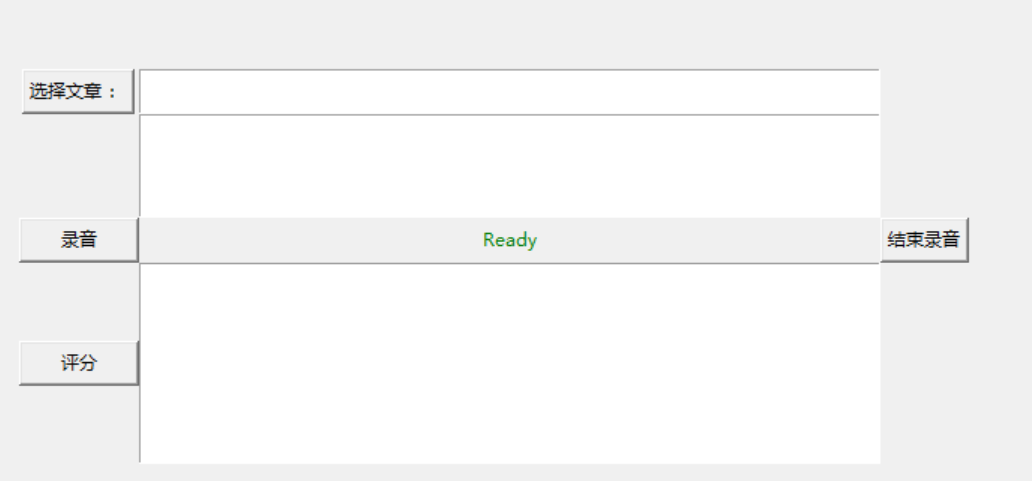記一次智慧語音軟體的開發-終於為孩子找到了個靠譜的口語老師
阿新 • • 發佈:2020-11-27
# 記一次智慧語音軟體的開發-終於為孩子找到了個靠譜的口語老師
“再窮不能窮教育,再苦不能苦孩子”,作為娃的爸媽,不僅僅要努力工作保證物質支援,更要關注娃的學習狀況,而且時刻都怕娃“輸在了起跑線上”,可是,現在孩子們的起跑線也太多了點,英語、各種藝術特長,甚至跳繩,忙的不亦樂乎。然而家長也不是全才啊,這不,我的姐姐最近就開始發愁女兒的英語口語問題了,自己發音不準確,報班又不知道哪家靠譜,眼看著孩子就要落後於小夥伴了,瞭解到這個情況後,我拿出英語課本,想到自己每次都是60飄過的英語成績,又放了回去,拿起了我的武器——程式碼。

近些年自然語言處理已經成熟地應用在很多領域,智慧語音測評的使用成本早已是大眾所能承受。根據給娃糾正讀音的需求,我最終選擇呼叫靠譜的大廠,有道智雲的[API](https://ai.youdao.com/DOCSIRMA/html/%E6%99%BA%E8%83%BD%E8%AF%AD%E9%9F%B3%E8%AF%84%E6%B5%8B/API%E6%96%87%E6%A1%A3/%E6%99%BA%E8%83%BD%E8%AF%AD%E9%9F%B3%E8%AF%84%E6%B5%8B%E6%9C%8D%E5%8A%A1/%E6%99%BA%E8%83%BD%E8%AF%AD%E9%9F%B3%E8%AF%84%E6%B5%8B%E6%9C%8D%E5%8A%A1-API%E6%96%87%E6%A1%A3.html)來開發個簡易[語音評測程式](https://github.com/LemonQH/BatchISEDemo),或者稱之為——智慧口語老師!
### 呼叫API介面的準備工作
首先,是需要在有道智雲的個人頁面上建立例項、建立應用、繫結應用和例項,獲取到應用的id和金鑰。具體個人註冊的過程和應用建立過程詳見文章[分享一次批量檔案翻譯的開發過程](https://www.cnblogs.com/alchemystar/p/13645324.html)
 ### 開發過程詳細介紹
下面介紹具體的程式碼開發過程。
首先研究[官方文件](https://ai.youdao.com/DOCSIRMA/html/%E6%99%BA%E8%83%BD%E8%AF%AD%E9%9F%B3%E8%AF%84%E6%B5%8B/API%E6%96%87%E6%A1%A3/%E6%99%BA%E8%83%BD%E8%AF%AD%E9%9F%B3%E8%AF%84%E6%B5%8B%E6%9C%8D%E5%8A%A1/%E6%99%BA%E8%83%BD%E8%AF%AD%E9%9F%B3%E8%AF%84%E6%B5%8B%E6%9C%8D%E5%8A%A1-API%E6%96%87%E6%A1%A3.html)給出的API輸入輸出規範。該API採用https方式通訊,簡單來說,就是將預先錄製好的聲音檔案編碼處理,簽名後提交給API,解析API返回的json即可得到評分結果。
介面地址:
> https介面: [https://openapi.youdao.com/iseap](https://openapi.youdao.com/iseapi)
API輸入所需引數如下表:
| 欄位名 | 型別 | 含義 | 必填 | 備註 |
| -------- | ---- | ------------------------------------------------------------ | ---- | ------------------------------------------------------------ |
| q | text | 要評測的音訊檔案的Base64編碼字串 | True | 必須是Base64編碼 |
| text | text | 要評測的音訊檔案對應的文字 | True | have a good day |
| langType | text | 源語言 | True | [支援語言](https://ai.youdao.com/DOCSIRMA/html/智慧語音評測/API文件/智慧語音評測服務/智慧語音評測服務-API文件.html#section-9) |
| appKey | text | 應用ID | True | 可在 [應用管理](https://ai.youdao.com/appmgr.s) 檢視 |
| salt | text | UUID | True | UUID |
| curtime | text | 時間戳(秒) | True | TimeStamp |
| sign | text | 簽名,通過sha256(應用ID+input+salt+curtime+應用金鑰)生成;input的生成規則見表下的備註 | True | sha256(應用ID+input+salt+curtime+應用金鑰) |
| signType | text | 簽名型別 | True | v2 |
| format | text | 語音檔案的格式,wav | true | wav |
| rate | text | 取樣率,推薦 16000 採用率 | true | 16000 |
| channel | text | 聲道數, 僅支援單聲道,請填寫固定值1 | true | 1 |
| type | text | 上傳型別, 僅支援base64上傳,請填寫固定值1 | true | 1 |
其中籤名`sign`生成方法如下:
signType=v2; sign=sha256(`應用ID`+`input`+`salt`+`curtime`+`應用金鑰`)。
這裡需要注意的是input的計算方式為:`input`=`q前10個字元` + `q長度` + `q後10個字元`(當q長度大於20)或 `input`=`q字串`(當q長度小於等於20)。
介面的輸出引數如下:
| 欄位 | 含義 |
| --------------- | ------------------------------------------------------------ |
| errorCode | 識別結果錯誤碼,一定存在。 詳細資訊可見 [錯誤程式碼列表](https://ai.youdao.com/DOCSIRMA/html/智慧語音評測/API文件/智慧語音評測服務/智慧語音評測服務-API文件.html#section-10) |
| refText | 請求的文字 |
| start | 音訊中句子開始時間,單位是秒 |
| end | 音訊中句子結束時間,單位是秒 |
| integrity | 句子完整度得分 |
| fluency | 句子流利度得分 |
| pronunciation | 句子準確度得分 |
| speed | 語速,單詞/分鐘 |
| overall | 句子綜合評分 |
| words | 單詞評分陣列 |
| -word | 單詞 |
| -start | 單詞開始時間,單位是秒 |
| -end | 單詞結束時間,單位是秒 |
| -pronunciation | 單詞準確度得分 |
| -phonemes | 音標陣列 |
| --phoneme | 音標 |
| --start | 音標開始時間,單位是秒 |
| --end | 音標結束時間,單位是秒 |
| --judge | 判斷音素是否錯誤,true為發音正確,false為發音錯誤,同時calibration給出提示 |
| --calibration | 如果發音錯誤,提示使用者該發音像什麼 |
| --prominence | 重音程度,分數越高,當前音標越可能是重音,分數在[0 100] |
| --stress_ref | 母音重音參考/標準答案,如果為true,說明參考答案認為該母音應該發重音,子音時無意義 |
| --stress_detect | 在一個單詞中,使用者該音標發音為重音 |
#### Demo開發:
這個demo使用python3開發,包括maindow.py,audioandprocess.py,isebynetease.py 三個檔案,分別為demo的介面、錄音以及其他邏輯處理和智慧語音評測介面呼叫方法的封裝。
1. ##### 介面部分:
UI 部分大體分為三部分,文章處理區域、錄音區域和評分展示區域。
### 開發過程詳細介紹
下面介紹具體的程式碼開發過程。
首先研究[官方文件](https://ai.youdao.com/DOCSIRMA/html/%E6%99%BA%E8%83%BD%E8%AF%AD%E9%9F%B3%E8%AF%84%E6%B5%8B/API%E6%96%87%E6%A1%A3/%E6%99%BA%E8%83%BD%E8%AF%AD%E9%9F%B3%E8%AF%84%E6%B5%8B%E6%9C%8D%E5%8A%A1/%E6%99%BA%E8%83%BD%E8%AF%AD%E9%9F%B3%E8%AF%84%E6%B5%8B%E6%9C%8D%E5%8A%A1-API%E6%96%87%E6%A1%A3.html)給出的API輸入輸出規範。該API採用https方式通訊,簡單來說,就是將預先錄製好的聲音檔案編碼處理,簽名後提交給API,解析API返回的json即可得到評分結果。
介面地址:
> https介面: [https://openapi.youdao.com/iseap](https://openapi.youdao.com/iseapi)
API輸入所需引數如下表:
| 欄位名 | 型別 | 含義 | 必填 | 備註 |
| -------- | ---- | ------------------------------------------------------------ | ---- | ------------------------------------------------------------ |
| q | text | 要評測的音訊檔案的Base64編碼字串 | True | 必須是Base64編碼 |
| text | text | 要評測的音訊檔案對應的文字 | True | have a good day |
| langType | text | 源語言 | True | [支援語言](https://ai.youdao.com/DOCSIRMA/html/智慧語音評測/API文件/智慧語音評測服務/智慧語音評測服務-API文件.html#section-9) |
| appKey | text | 應用ID | True | 可在 [應用管理](https://ai.youdao.com/appmgr.s) 檢視 |
| salt | text | UUID | True | UUID |
| curtime | text | 時間戳(秒) | True | TimeStamp |
| sign | text | 簽名,通過sha256(應用ID+input+salt+curtime+應用金鑰)生成;input的生成規則見表下的備註 | True | sha256(應用ID+input+salt+curtime+應用金鑰) |
| signType | text | 簽名型別 | True | v2 |
| format | text | 語音檔案的格式,wav | true | wav |
| rate | text | 取樣率,推薦 16000 採用率 | true | 16000 |
| channel | text | 聲道數, 僅支援單聲道,請填寫固定值1 | true | 1 |
| type | text | 上傳型別, 僅支援base64上傳,請填寫固定值1 | true | 1 |
其中籤名`sign`生成方法如下:
signType=v2; sign=sha256(`應用ID`+`input`+`salt`+`curtime`+`應用金鑰`)。
這裡需要注意的是input的計算方式為:`input`=`q前10個字元` + `q長度` + `q後10個字元`(當q長度大於20)或 `input`=`q字串`(當q長度小於等於20)。
介面的輸出引數如下:
| 欄位 | 含義 |
| --------------- | ------------------------------------------------------------ |
| errorCode | 識別結果錯誤碼,一定存在。 詳細資訊可見 [錯誤程式碼列表](https://ai.youdao.com/DOCSIRMA/html/智慧語音評測/API文件/智慧語音評測服務/智慧語音評測服務-API文件.html#section-10) |
| refText | 請求的文字 |
| start | 音訊中句子開始時間,單位是秒 |
| end | 音訊中句子結束時間,單位是秒 |
| integrity | 句子完整度得分 |
| fluency | 句子流利度得分 |
| pronunciation | 句子準確度得分 |
| speed | 語速,單詞/分鐘 |
| overall | 句子綜合評分 |
| words | 單詞評分陣列 |
| -word | 單詞 |
| -start | 單詞開始時間,單位是秒 |
| -end | 單詞結束時間,單位是秒 |
| -pronunciation | 單詞準確度得分 |
| -phonemes | 音標陣列 |
| --phoneme | 音標 |
| --start | 音標開始時間,單位是秒 |
| --end | 音標結束時間,單位是秒 |
| --judge | 判斷音素是否錯誤,true為發音正確,false為發音錯誤,同時calibration給出提示 |
| --calibration | 如果發音錯誤,提示使用者該發音像什麼 |
| --prominence | 重音程度,分數越高,當前音標越可能是重音,分數在[0 100] |
| --stress_ref | 母音重音參考/標準答案,如果為true,說明參考答案認為該母音應該發重音,子音時無意義 |
| --stress_detect | 在一個單詞中,使用者該音標發音為重音 |
#### Demo開發:
這個demo使用python3開發,包括maindow.py,audioandprocess.py,isebynetease.py 三個檔案,分別為demo的介面、錄音以及其他邏輯處理和智慧語音評測介面呼叫方法的封裝。
1. ##### 介面部分:
UI 部分大體分為三部分,文章處理區域、錄音區域和評分展示區域。

 ### 開發過程詳細介紹
下面介紹具體的程式碼開發過程。
首先研究[官方文件](https://ai.youdao.com/DOCSIRMA/html/%E6%99%BA%E8%83%BD%E8%AF%AD%E9%9F%B3%E8%AF%84%E6%B5%8B/API%E6%96%87%E6%A1%A3/%E6%99%BA%E8%83%BD%E8%AF%AD%E9%9F%B3%E8%AF%84%E6%B5%8B%E6%9C%8D%E5%8A%A1/%E6%99%BA%E8%83%BD%E8%AF%AD%E9%9F%B3%E8%AF%84%E6%B5%8B%E6%9C%8D%E5%8A%A1-API%E6%96%87%E6%A1%A3.html)給出的API輸入輸出規範。該API採用https方式通訊,簡單來說,就是將預先錄製好的聲音檔案編碼處理,簽名後提交給API,解析API返回的json即可得到評分結果。
介面地址:
> https介面: [https://openapi.youdao.com/iseap](https://openapi.youdao.com/iseapi)
API輸入所需引數如下表:
| 欄位名 | 型別 | 含義 | 必填 | 備註 |
| -------- | ---- | ------------------------------------------------------------ | ---- | ------------------------------------------------------------ |
| q | text | 要評測的音訊檔案的Base64編碼字串 | True | 必須是Base64編碼 |
| text | text | 要評測的音訊檔案對應的文字 | True | have a good day |
| langType | text | 源語言 | True | [支援語言](https://ai.youdao.com/DOCSIRMA/html/智慧語音評測/API文件/智慧語音評測服務/智慧語音評測服務-API文件.html#section-9) |
| appKey | text | 應用ID | True | 可在 [應用管理](https://ai.youdao.com/appmgr.s) 檢視 |
| salt | text | UUID | True | UUID |
| curtime | text | 時間戳(秒) | True | TimeStamp |
| sign | text | 簽名,通過sha256(應用ID+input+salt+curtime+應用金鑰)生成;input的生成規則見表下的備註 | True | sha256(應用ID+input+salt+curtime+應用金鑰) |
| signType | text | 簽名型別 | True | v2 |
| format | text | 語音檔案的格式,wav | true | wav |
| rate | text | 取樣率,推薦 16000 採用率 | true | 16000 |
| channel | text | 聲道數, 僅支援單聲道,請填寫固定值1 | true | 1 |
| type | text | 上傳型別, 僅支援base64上傳,請填寫固定值1 | true | 1 |
其中籤名`sign`生成方法如下:
signType=v2; sign=sha256(`應用ID`+`input`+`salt`+`curtime`+`應用金鑰`)。
這裡需要注意的是input的計算方式為:`input`=`q前10個字元` + `q長度` + `q後10個字元`(當q長度大於20)或 `input`=`q字串`(當q長度小於等於20)。
介面的輸出引數如下:
| 欄位 | 含義 |
| --------------- | ------------------------------------------------------------ |
| errorCode | 識別結果錯誤碼,一定存在。 詳細資訊可見 [錯誤程式碼列表](https://ai.youdao.com/DOCSIRMA/html/智慧語音評測/API文件/智慧語音評測服務/智慧語音評測服務-API文件.html#section-10) |
| refText | 請求的文字 |
| start | 音訊中句子開始時間,單位是秒 |
| end | 音訊中句子結束時間,單位是秒 |
| integrity | 句子完整度得分 |
| fluency | 句子流利度得分 |
| pronunciation | 句子準確度得分 |
| speed | 語速,單詞/分鐘 |
| overall | 句子綜合評分 |
| words | 單詞評分陣列 |
| -word | 單詞 |
| -start | 單詞開始時間,單位是秒 |
| -end | 單詞結束時間,單位是秒 |
| -pronunciation | 單詞準確度得分 |
| -phonemes | 音標陣列 |
| --phoneme | 音標 |
| --start | 音標開始時間,單位是秒 |
| --end | 音標結束時間,單位是秒 |
| --judge | 判斷音素是否錯誤,true為發音正確,false為發音錯誤,同時calibration給出提示 |
| --calibration | 如果發音錯誤,提示使用者該發音像什麼 |
| --prominence | 重音程度,分數越高,當前音標越可能是重音,分數在[0 100] |
| --stress_ref | 母音重音參考/標準答案,如果為true,說明參考答案認為該母音應該發重音,子音時無意義 |
| --stress_detect | 在一個單詞中,使用者該音標發音為重音 |
#### Demo開發:
這個demo使用python3開發,包括maindow.py,audioandprocess.py,isebynetease.py 三個檔案,分別為demo的介面、錄音以及其他邏輯處理和智慧語音評測介面呼叫方法的封裝。
1. ##### 介面部分:
UI 部分大體分為三部分,文章處理區域、錄音區域和評分展示區域。
### 開發過程詳細介紹
下面介紹具體的程式碼開發過程。
首先研究[官方文件](https://ai.youdao.com/DOCSIRMA/html/%E6%99%BA%E8%83%BD%E8%AF%AD%E9%9F%B3%E8%AF%84%E6%B5%8B/API%E6%96%87%E6%A1%A3/%E6%99%BA%E8%83%BD%E8%AF%AD%E9%9F%B3%E8%AF%84%E6%B5%8B%E6%9C%8D%E5%8A%A1/%E6%99%BA%E8%83%BD%E8%AF%AD%E9%9F%B3%E8%AF%84%E6%B5%8B%E6%9C%8D%E5%8A%A1-API%E6%96%87%E6%A1%A3.html)給出的API輸入輸出規範。該API採用https方式通訊,簡單來說,就是將預先錄製好的聲音檔案編碼處理,簽名後提交給API,解析API返回的json即可得到評分結果。
介面地址:
> https介面: [https://openapi.youdao.com/iseap](https://openapi.youdao.com/iseapi)
API輸入所需引數如下表:
| 欄位名 | 型別 | 含義 | 必填 | 備註 |
| -------- | ---- | ------------------------------------------------------------ | ---- | ------------------------------------------------------------ |
| q | text | 要評測的音訊檔案的Base64編碼字串 | True | 必須是Base64編碼 |
| text | text | 要評測的音訊檔案對應的文字 | True | have a good day |
| langType | text | 源語言 | True | [支援語言](https://ai.youdao.com/DOCSIRMA/html/智慧語音評測/API文件/智慧語音評測服務/智慧語音評測服務-API文件.html#section-9) |
| appKey | text | 應用ID | True | 可在 [應用管理](https://ai.youdao.com/appmgr.s) 檢視 |
| salt | text | UUID | True | UUID |
| curtime | text | 時間戳(秒) | True | TimeStamp |
| sign | text | 簽名,通過sha256(應用ID+input+salt+curtime+應用金鑰)生成;input的生成規則見表下的備註 | True | sha256(應用ID+input+salt+curtime+應用金鑰) |
| signType | text | 簽名型別 | True | v2 |
| format | text | 語音檔案的格式,wav | true | wav |
| rate | text | 取樣率,推薦 16000 採用率 | true | 16000 |
| channel | text | 聲道數, 僅支援單聲道,請填寫固定值1 | true | 1 |
| type | text | 上傳型別, 僅支援base64上傳,請填寫固定值1 | true | 1 |
其中籤名`sign`生成方法如下:
signType=v2; sign=sha256(`應用ID`+`input`+`salt`+`curtime`+`應用金鑰`)。
這裡需要注意的是input的計算方式為:`input`=`q前10個字元` + `q長度` + `q後10個字元`(當q長度大於20)或 `input`=`q字串`(當q長度小於等於20)。
介面的輸出引數如下:
| 欄位 | 含義 |
| --------------- | ------------------------------------------------------------ |
| errorCode | 識別結果錯誤碼,一定存在。 詳細資訊可見 [錯誤程式碼列表](https://ai.youdao.com/DOCSIRMA/html/智慧語音評測/API文件/智慧語音評測服務/智慧語音評測服務-API文件.html#section-10) |
| refText | 請求的文字 |
| start | 音訊中句子開始時間,單位是秒 |
| end | 音訊中句子結束時間,單位是秒 |
| integrity | 句子完整度得分 |
| fluency | 句子流利度得分 |
| pronunciation | 句子準確度得分 |
| speed | 語速,單詞/分鐘 |
| overall | 句子綜合評分 |
| words | 單詞評分陣列 |
| -word | 單詞 |
| -start | 單詞開始時間,單位是秒 |
| -end | 單詞結束時間,單位是秒 |
| -pronunciation | 單詞準確度得分 |
| -phonemes | 音標陣列 |
| --phoneme | 音標 |
| --start | 音標開始時間,單位是秒 |
| --end | 音標結束時間,單位是秒 |
| --judge | 判斷音素是否錯誤,true為發音正確,false為發音錯誤,同時calibration給出提示 |
| --calibration | 如果發音錯誤,提示使用者該發音像什麼 |
| --prominence | 重音程度,分數越高,當前音標越可能是重音,分數在[0 100] |
| --stress_ref | 母音重音參考/標準答案,如果為true,說明參考答案認為該母音應該發重音,子音時無意義 |
| --stress_detect | 在一個單詞中,使用者該音標發音為重音 |
#### Demo開發:
這個demo使用python3開發,包括maindow.py,audioandprocess.py,isebynetease.py 三個檔案,分別為demo的介面、錄音以及其他邏輯處理和智慧語音評測介面呼叫方法的封裝。
1. ##### 介面部分:
UI 部分大體分為三部分,文章處理區域、錄音區域和評分展示區域。

